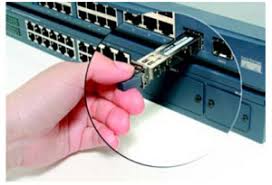Posted By: technopediasite

What is Fiber Optic Transceivers Modules?
An optical transceiver chip is an integrated circuit (IC) that transmits and receives data using optical fiber rather than electrical wire. Optical transceiver chips facilitate the use of fiber to the premises (FTTP) services, in which optical fiber runs from central hubs all the way to the end users. This can provide extremely high-speed Internet access. Optical fiber systems can also be used to transmit and receive telephone communications and to receive digital television broadcasts.
SFP Optical Transceivers Small Form Pluggable Optical Modules
- Multimode and single-mode fiber
- Gigabit Ethernet, Fast Ethernet, Fiber channel, ATM/SONET, SDH
- Hot-pluggable with durable metal enclosure
- Can be installed in any Cisco or MSA SFF-8472 compliant port
- Enhanced digital diagnostic information
- CWDM modules available supporting standard wavelengths defined by ITU-T G.694.2
- 32F to 158F (0C to 70C) and -40F to 185F (-40C to+85C ) SFP case operating temperatures
Fiber Optic Transceivers Modules
An optical fiber transceiver is also called fiber optic transmitter and receiver, the function of the optical module is photoelectric conversion. The transmitter end takes in and converts the electrical signal into light, after the optical fiber transmission in the fiber cable plant, the receiver end again converts the light signal into electrical signal. Both the receiver and the transmitter ends have their own circuitry and can handle transmissions in both directions.
There are a number of different types of fiber optic transceivers available in the market. They differ in the type of connections, data transmission speed, as well as packing forms. According to the package, common type of fiber optic transceivers popular in the market is SFP, SFP+, XFP, X2, Xenpak, GBIC. According to the fiber type it connect to, there are MM (multimode), SM (Single mode), as well as WDM fiber (CWDM, DWDM modules).
Applications of Transceiver Modules
- FTTH (GPON, GEPON, Point to Point)
- Base Station (3G SFP CPRI/ 6G SFP+ CPRI)
- Fiber channel (4G SFP/ 8G SFP+)
- Ethernet systems (from 100Mbps to 10Gbps with different form factor / SFF, SFP, XFP and SFP+). Oldest modules, and their existence is still popular, based on their large install base. The newest modules are the SFP+ making a small form factor that has the ability to offer very fast internet connectivity.
-SFP doesn't support 10G transmission data rate that means they can't be used in the same network.
- From the price, SFP+ is more expensive than SFP+
- SFP is based on IEEE802.3 and SFF-8472 while SFP+ is based on SFF-8431.
- Both of them are 10G fiber optical modules and can connect with other type of 10G modules.
- The size of SFP+ is smaller than XFP, thus it moves some functions to motherboard, including signal modulation function, MAC, CDR and EDC.
- XFP is based on the standard of XFP MSA
- SFP+ is compliance with the protocol of IEEE802.3ae, SFF-8431, SFF-8432.
- SFP+ is the mainstream design.
- SFP and SFP+ have the same appearance and same size
- From the price, SFP+ is more expensive than SFP+
- SFP is based on IEEE802.3 and SFF-8472 while SFP+ is based on SFF-8431.
- Both of them are 10G fiber optical modules and can connect with other type of 10G modules.
- The size of SFP+ is smaller than XFP, thus it moves some functions to motherboard, including signal modulation function, MAC, CDR and EDC.
- XFP is based on the standard of XFP MSA
- SFP+ is compliance with the protocol of IEEE802.3ae, SFF-8431, SFF-8432.
- SFP+ is the mainstream design.
- SFP and SFP+ have the same appearance and same size
Advantages of SFP+ Module
- SFP+ has a more compact form factor package than X2 and XFP.
- It can connect with the same type of XFP, X2 and XENPAK directly.
- The cost of SFP+ is lower than XFP, X2 and XENPAK.
Please give your feedback & also share to our telecom friends/telecom groups. I will be happy to discuss more about the telecom sector .





0 Comments